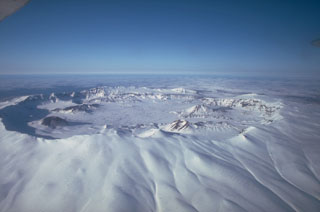Report on Okmok (United States) — January 1987
Scientific Event Alert Network Bulletin, vol. 12, no. 1 (January 1987)
Managing Editor: Lindsay McClelland.
Okmok (United States) Ash emission declines
Please cite this report as:
Global Volcanism Program, 1987. Report on Okmok (United States) (McClelland, L., ed.). Scientific Event Alert Network Bulletin, 12:1. Smithsonian Institution. https://doi.org/10.5479/si.GVP.SEAN198701-311290
Okmok
United States
53.43°N, 168.13°W; summit elev. 1073 m
All times are local (unless otherwise noted)
At 1600 on 18 December, pilot T. Madsen observed steam and ash emission from the cinder cone in the SW part of the caldera. During the next 2 hours about six large pulses of ash rose 900 m above the cone. Madsen observed a trace of fresh ash when he landed on the SE flank. At 1800, ash was drifting NE for ~55 km, and the S and SW part of the caldera floor were completely covered with black ash.
When H. Wilson flew by the caldera on the afternoon of 19 January, no ash was penetrating the 1,200-m cloud cover, although he noted increased stream flow from the NNE part of the crater. On 2 February a 60-m steam plume containing small amounts of grey ash rose from the cone but on 11 February pilot Dwight Blackburn reported only minor white steam emission.
Geological Summary. The broad, basaltic Okmok shield volcano, which forms the NE end of Umnak Island, has a dramatically different profile than most other Aleutian volcanoes. The summit of the low, 35-km-wide volcano is cut by two overlapping 10-km-wide calderas formed during eruptions about 12,000 and 2050 years ago that produced dacitic pyroclastic flows that reached the coast. More than 60 tephra layers from Okmok have been found overlying the 12,000-year-old caldera-forming tephra layer. Numerous satellitic cones and lava domes dot the flanks of the volcano down to the coast, including 1253-m Mount Tulik on the SE flank, which is almost 200 m higher than the caldera rim. Some of the post-caldera cones show evidence of wave-cut lake terraces; the more recent cones, some of which have been active historically, were formed after the caldera lake, once 150 m deep, disappeared. Hot springs and fumaroles are found within the caldera. Historical eruptions have occurred since 1805 from cinder cones within the caldera.
Information Contacts: J. Reeder, Alaska Division of Geological and Geophysical Surveys (ADGGS).

